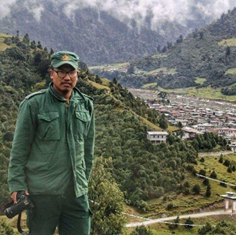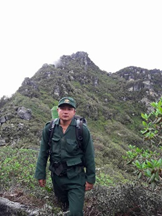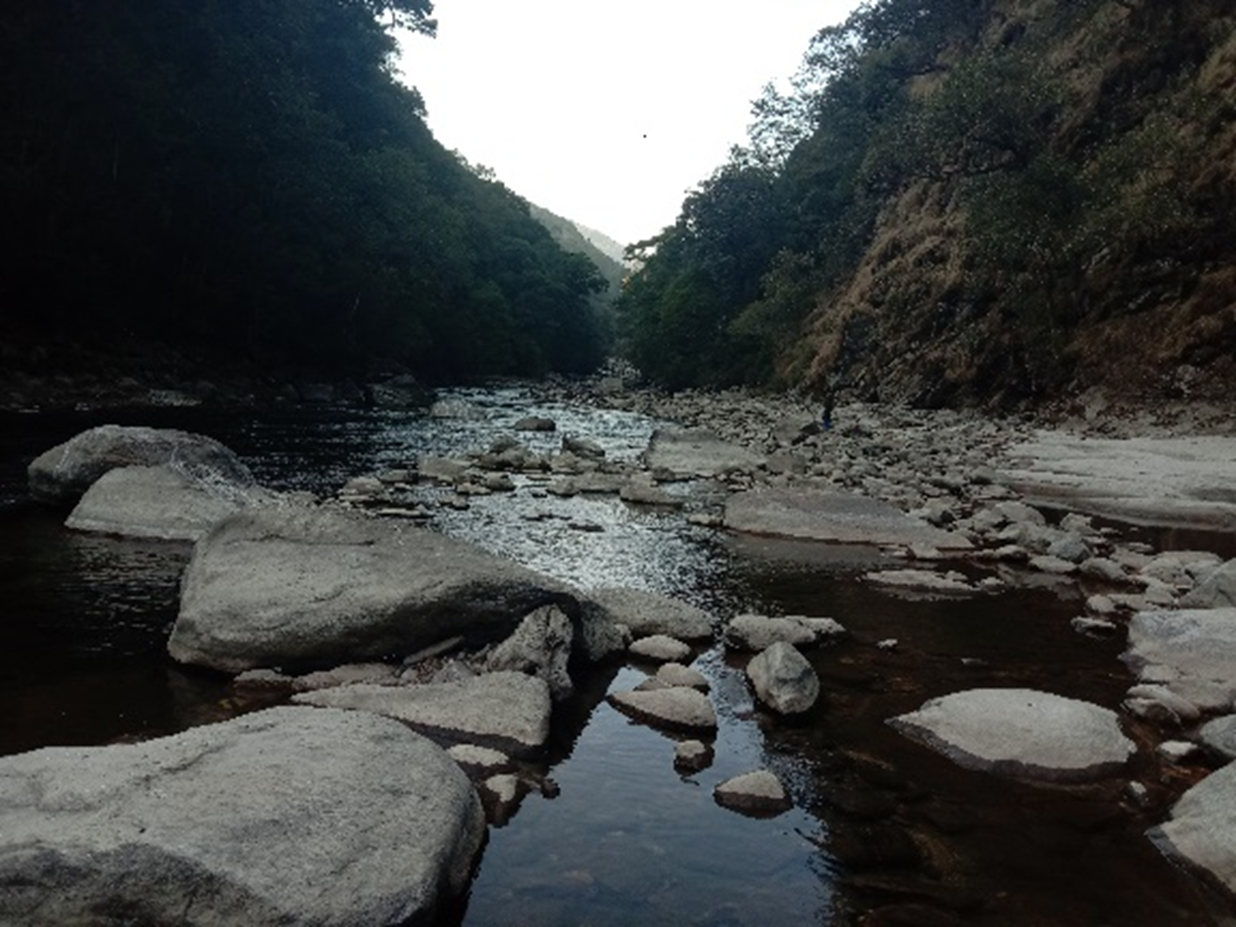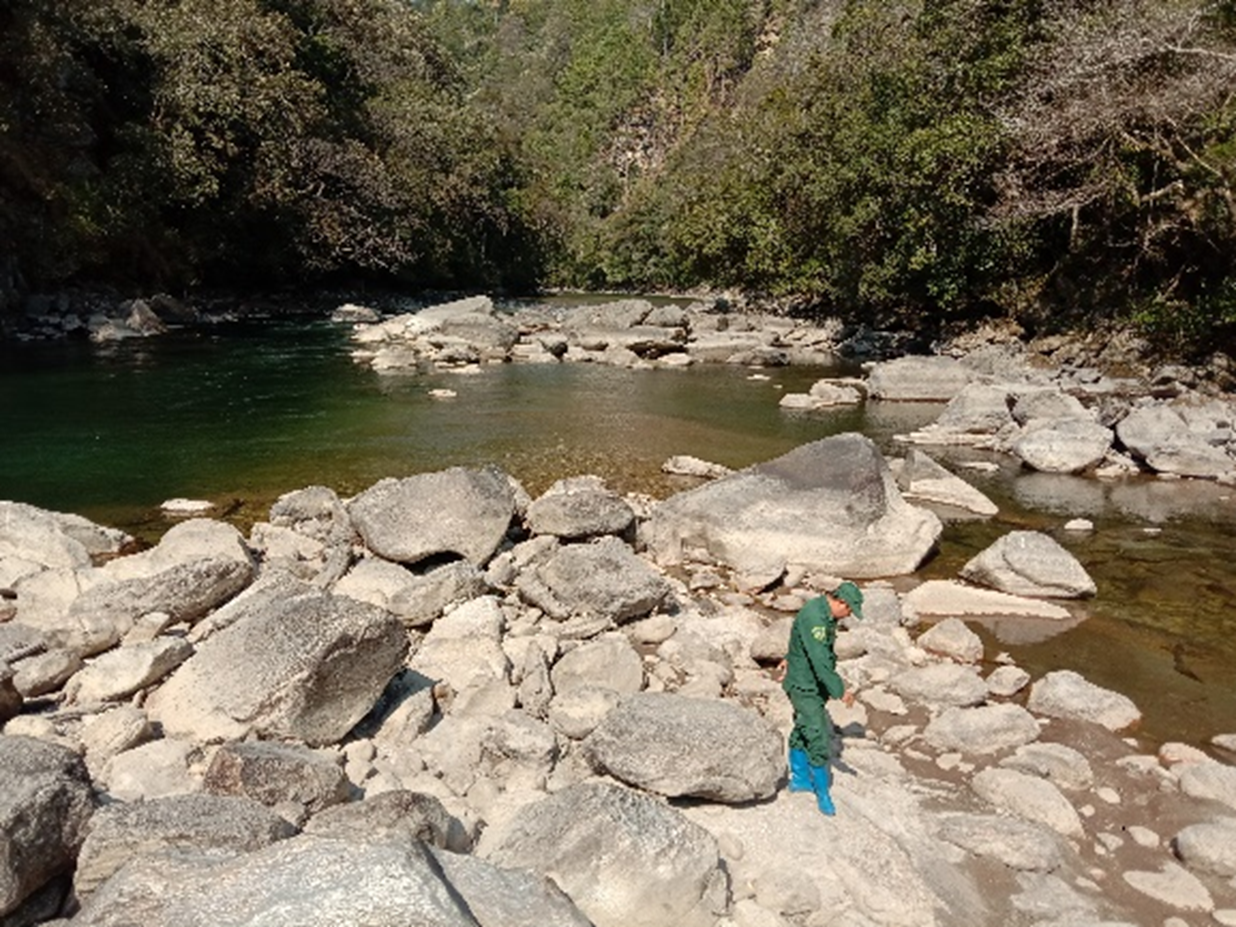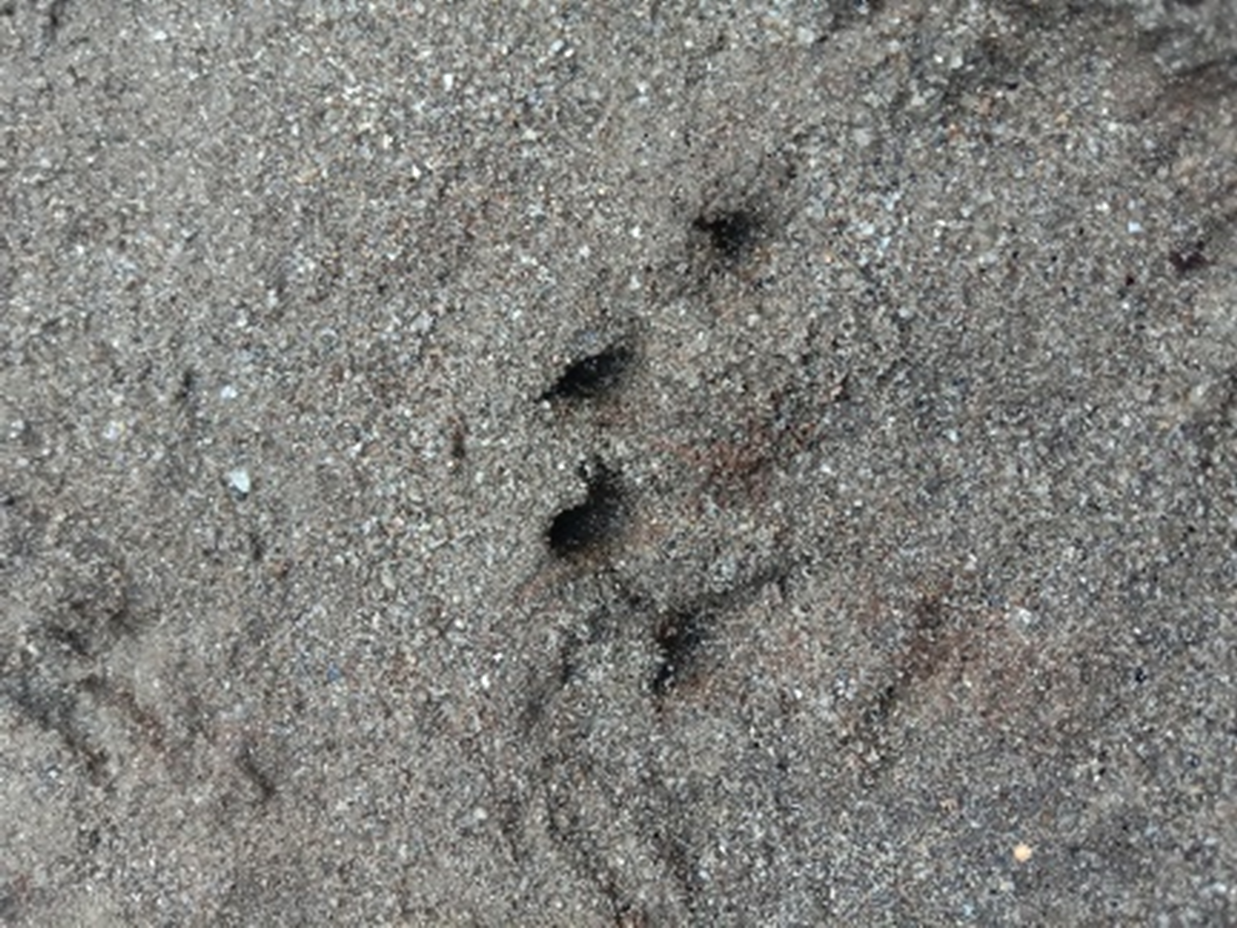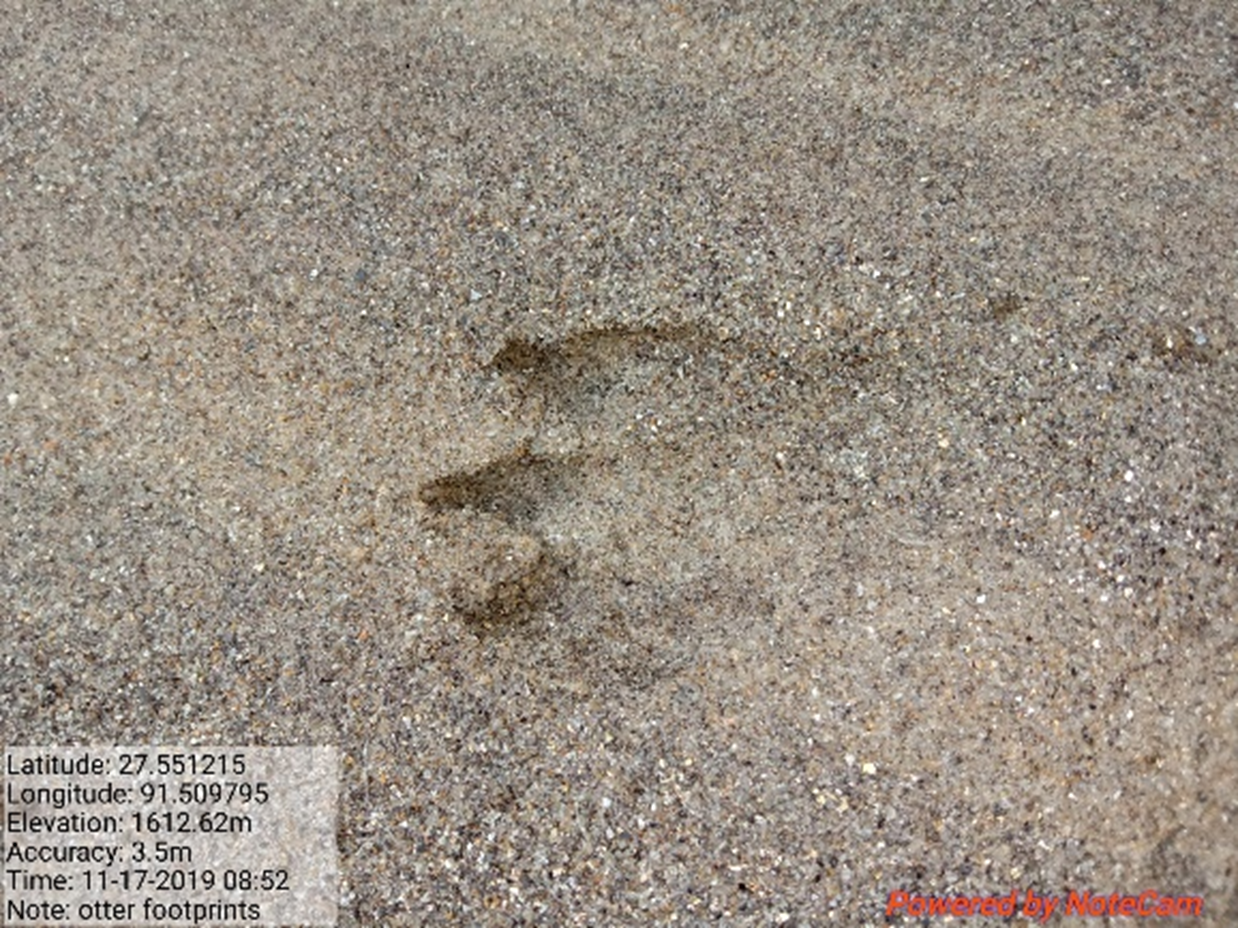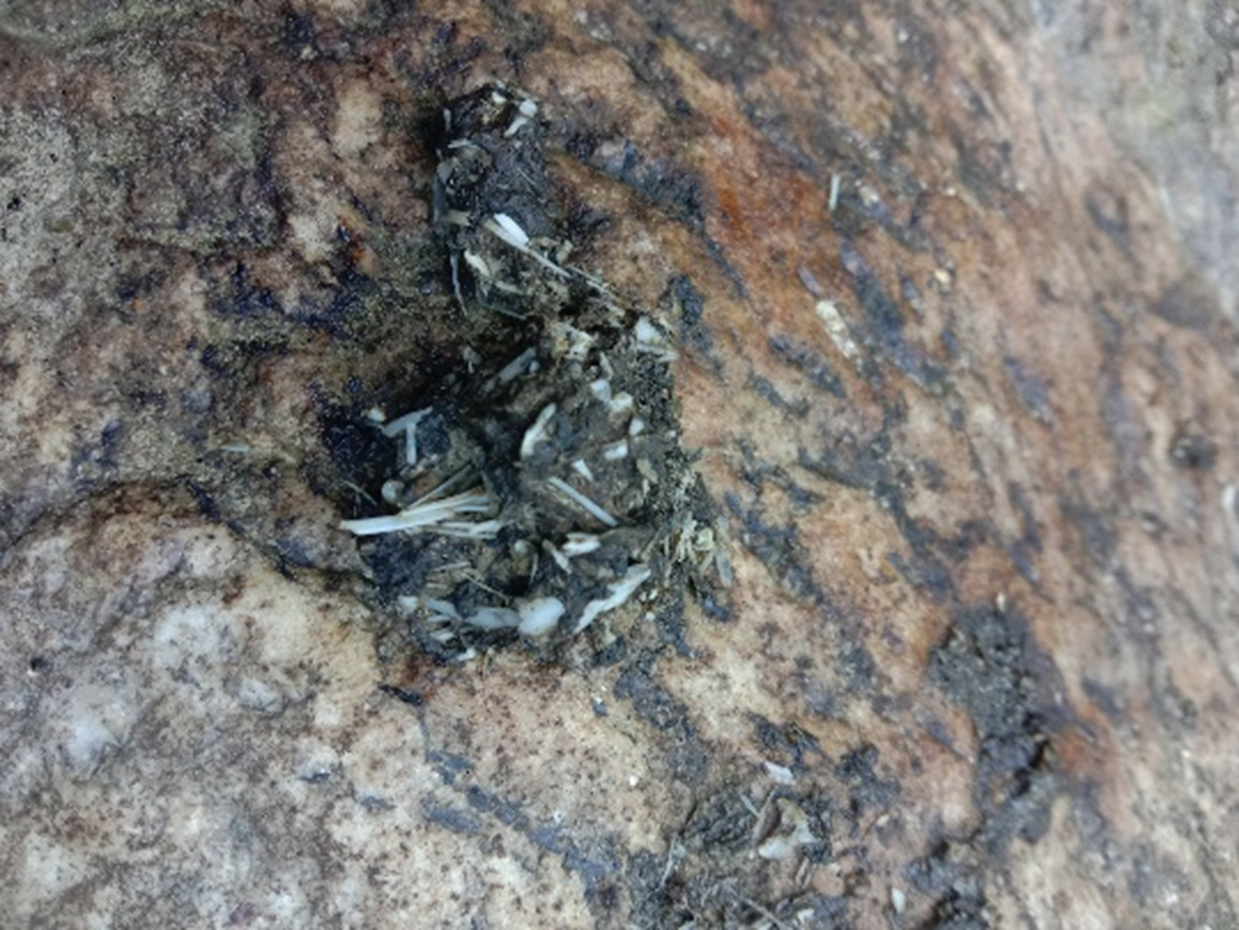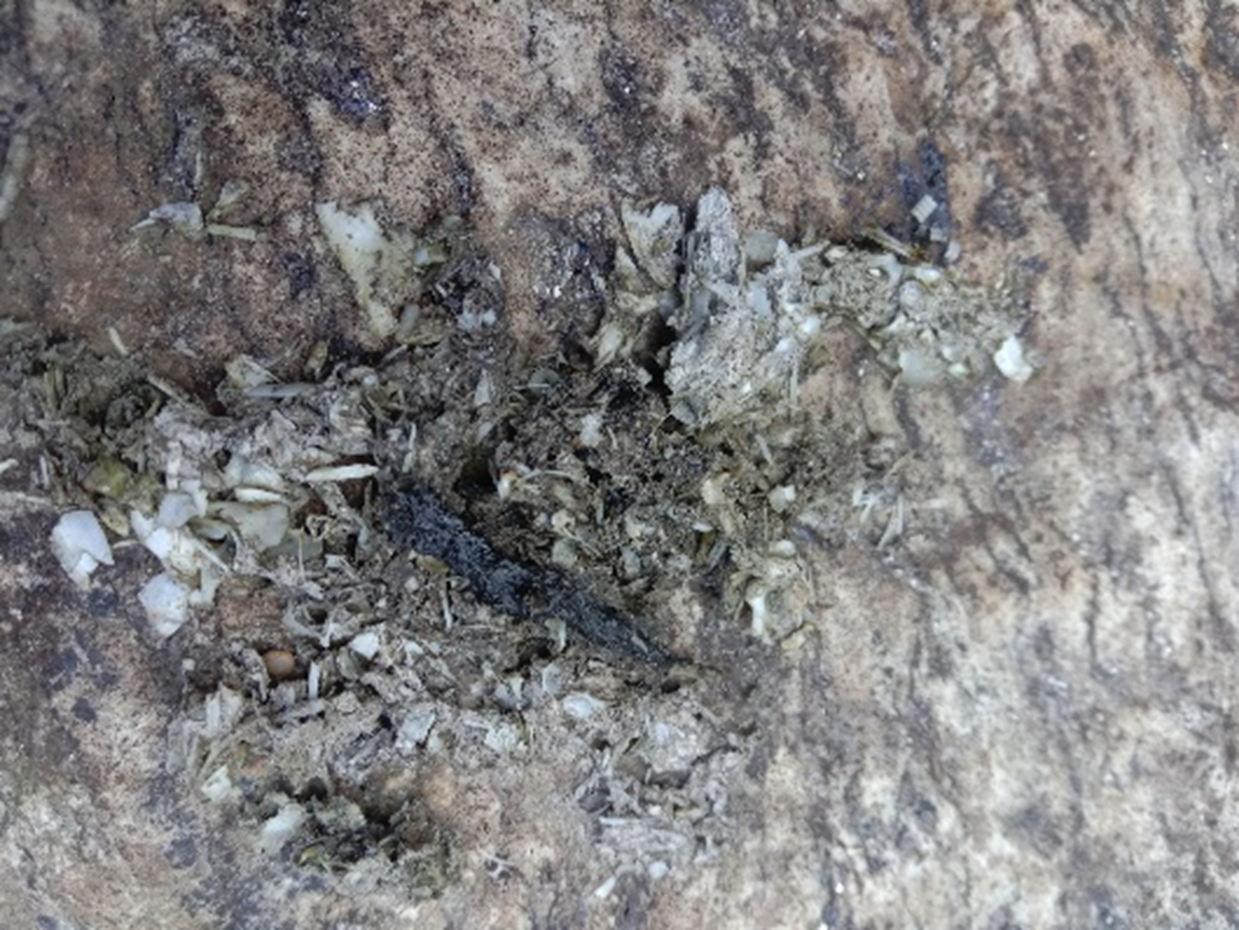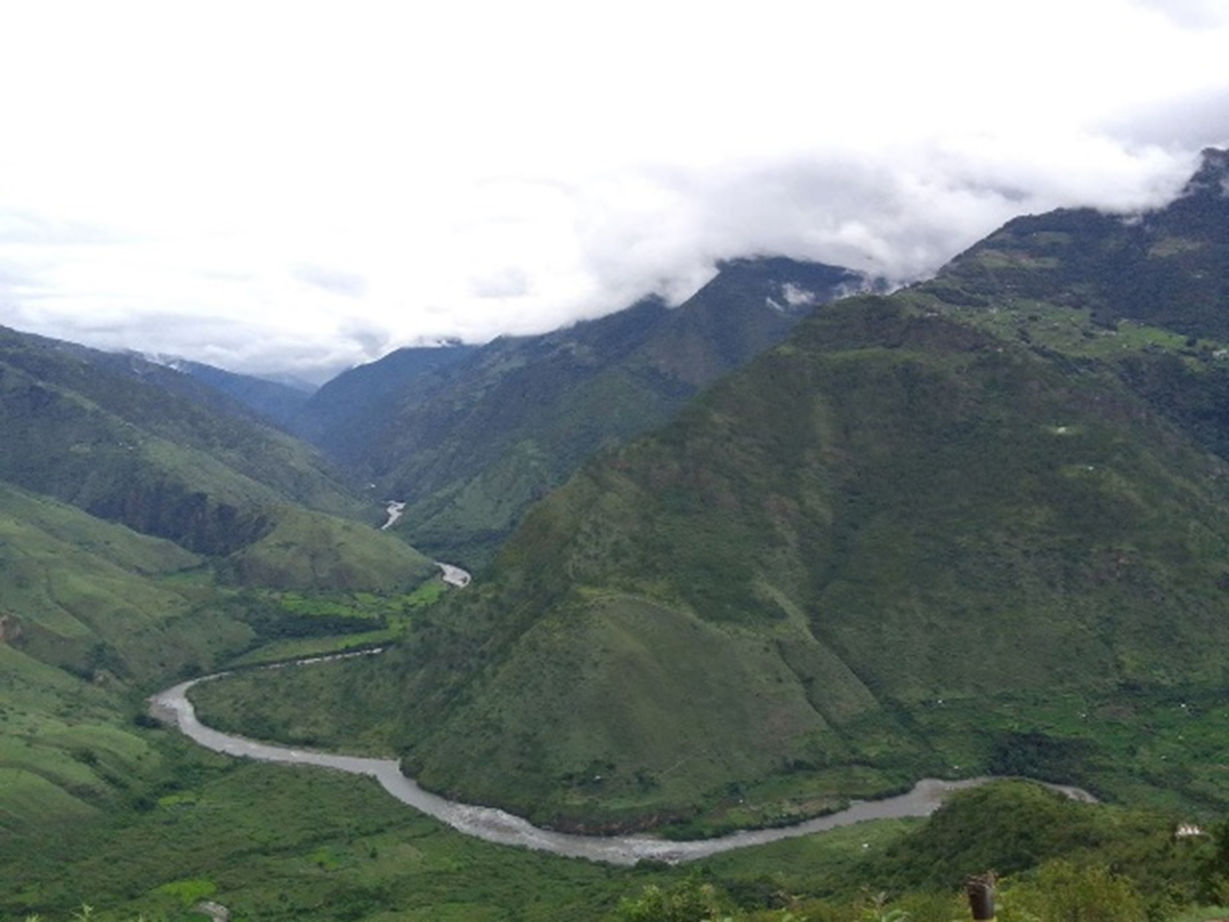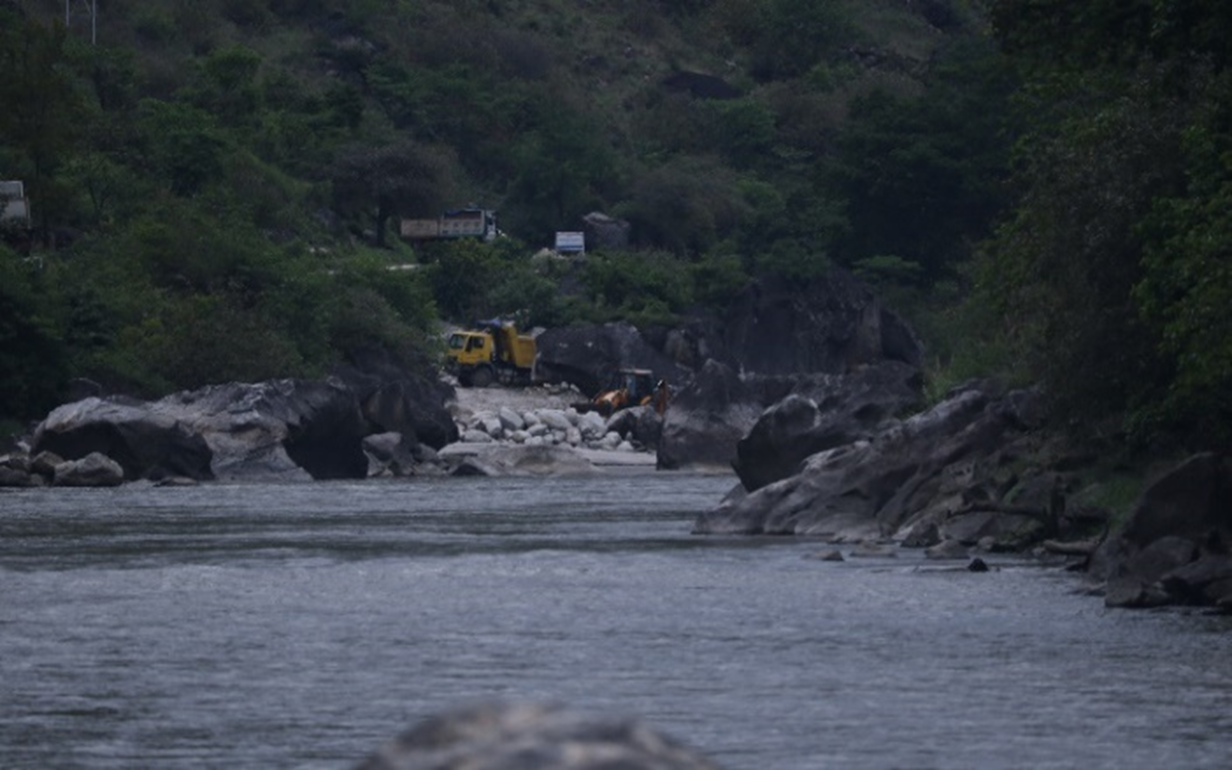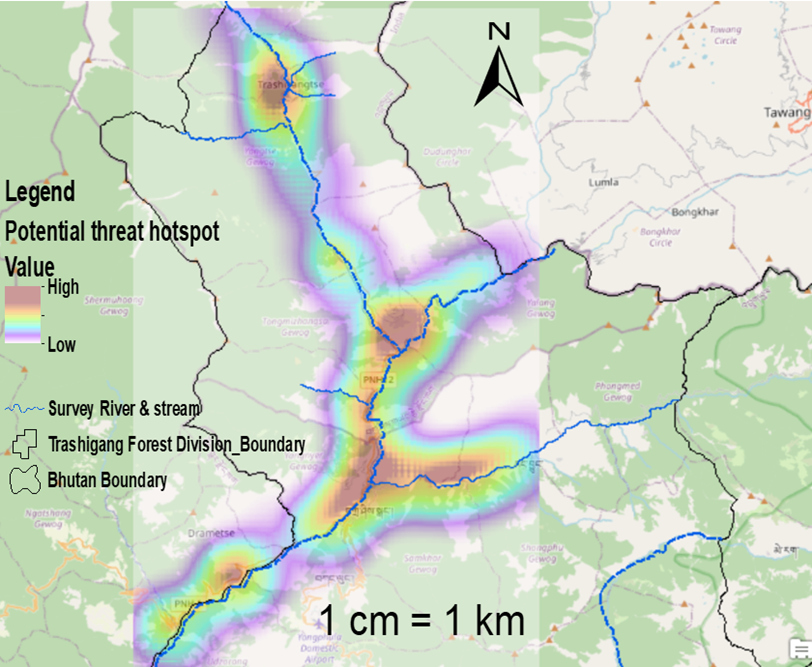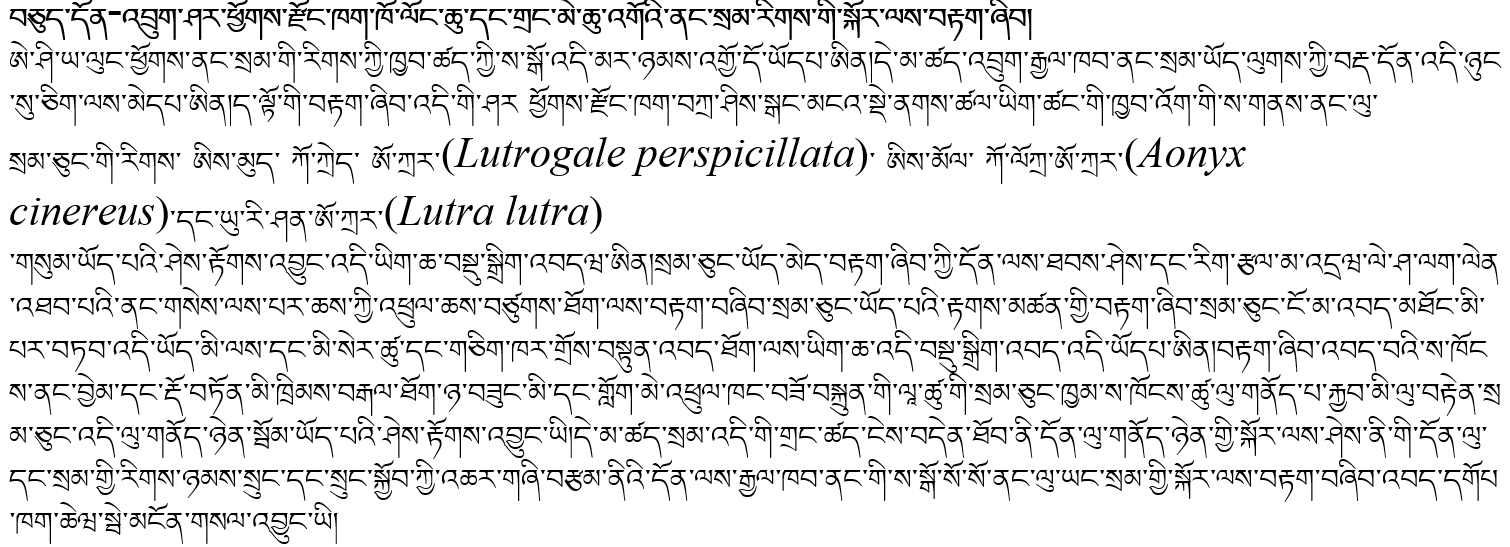IUCN/SSC Otter Specialist Group Bulletin

©IUCN/SCC Otter Specialist Group
Volume 41 Issue 3 (October 2024)
Citation: Norbu, L., Jamtsho, T., Jamtsho, K., Tenzin, P., and Lhendup, U. (2024). A Survey of Otters in the Kholongchu and Upper Drangmechu Rivers, Eastern Bhutan. IUCN Otter Spec. Group Bull. 41 (3):125 - 139
A Survey of Otters in the Kholongchu and Upper Drangmechu Rivers, Eastern Bhutan
Lam Norbu1*, Tandin Jamtsho1, Karma Jamtsho1, Pema Tenzin1, and Ugyen Lhendup2
1Tashigang Forest Division, Department of Forest and Park Services, Tashigang, Bhutan
2Bumthang Forest Division, Department of Forest and Park Services, Bumtahng, Bhutan
*Corresponding Author Email: lamnorbu0@gmail.com
Received 5th January 2024, accepted 18th January 2024
Abstract: Otter species are declining across their distribution range in asia. Only scanty information is available about the presence of otters in Bhutan. This study documents the presence of three otter species, the smooth-coated otter (Lutrogale perspicillata), the small-clawed otter (Aonyx cinereus) and eurasian otter (Lutra lutra), in the landscape of Trashigang forest division in Eastern Bhutan. Multiple techniques were used to document otter presence, including camera trap survey, sign survey, direct sighting, reliable photographic evidence, found specimens, and public consultation. Habitat disturbances including sand mining and quarry, unregulated fishing and hydropower construction were identified as significant threats to otters in the study region. Further systematic otter surveys are needed in the region and other parts of the country to make an accurate population assessment, understand threats, and develop effective conservation strategies for the protection of otter species in Bhutan.
Keywords: Smooth-coated otter, Small-clawed otter, Eurasian otter, Bhutan, conservation
INTRODUCTION
Thirteen species of otters exist globally, with five species in Asia (Basnet et al., 2020). The Smooth-coated otter Lutrogale perspicillata, the Small-clawed otter Aonyx cinereus, and the Eurasian otter Lutra lutra are the three extant species in the eastern Himalayas (Khatiwara and Bhutia, 2020; Borker et al., 2022). The Red List of the International Union for the Conservation of Nature (IUCN) classifies the first two species as Vulnerable (Duplaix and Savage, 2018), and the last as Near Threatened owing to sharp population declines across their range (Savage, 2022). The Smooth-coated otter and the Eurasian otter are listed in CITES Appendix I (Gupta et al., 2020).
Otters (Mustelidae) are semi-aquatic apex predators and keystone species in riverine ecosystems, and are recognized as ‘wetland ambassadors’ (Medhi et al., 2014). Prey mainly on fish but their diet may include reptiles, amphibians, snails, arthropods, aquatic invertebrates, crabs and occasionally birds (Gowtham et al., 2022; Naidu et al., 2022). There is little research on the distribution, ecology and conservation of otter species in Bhutan (De Silva, 2011).
Bhutan is part of the Eastern Himalayan Global Biodiversity Hotspot (Myers et al., 2000), and recognized as one of the 200 globally important eco-regions (Olson and Dinerstein, 2002). The country is abutted by India to the east (Arunachal Pradesh), south (Assam and West Bengal) and west (Sikkim), and China (Tibetan Autonomous Region) to the north. With over 38,394 sq.km, and undulating landscapes ranging in elevation from 65 to 7000 masl, the country has great biological significance. Commitment to conservation is strong in Bhutan, which harbours more than 200 mammal species (Wangchuk et al., 2004), with many globally threatened species. The Bhutan Forest and Nature Conservation Act 2023, and the 2023 Rules provision give robust legal protection status to otter species in the country.
There is little known about otter distribution in the country, and information about their conservation status is scanty. To our knowledge, only three studies in Bhutan have reliably reported the presence of otters (locally known as ‘chusham’). Chettri and Savage (2014) studied otter sign along the Punatshangchhu River in central Bhutan. Wangchuk et al. (2004) reported the presence of three species of otters. Gyeltshen and Dorji (2015) reported the occurrence of Eurasian otter and Small-clawed otter in Phrumshingla National Park (PNP).
In the neighbouring Indian state of Arunachal Pradesh, there are reports of all three otter species, Smooth-coated otter and Eurasian otter in Nyamjang Chu in western Tawang District (Medhi et al., 2014; Bhattacharya et al., 2019), and Small-clawed otter in Namdapha and Pakke Tiger Reserve in West Kameng District (Borker et al., 2022), reflecting otter populations with trans-boundary distributions with Bhutan (Medhi et al., 2014). Nyamjang Chu in Tawang District is one of the major headwaters of the Drangmechu River in eastern Bhutan. Moreover, 60.2 km of Trashigang Forest Division shares a northeastern boundary with Arunachal Pradesh (Tobgay et al., 2022). Two or three species of otter had been anecdotally reported to occur along the Drangmechu and Kholongchu Rivers inside Trashigang Forest Division in eastern Bhutan, but the identity of the species remain unconfirmed.
To address this knowledge gap, a rapid preliminary assessment was conducted in Trashigang Forest Division to document baseline information on otters in the region along the Kholongchu River and upper Drangmechu River and their tributaries.
STUDY AREA
The study focused on two river basins and their tributaries in Trashigang Forest Division, outside the protected areas of Trashigang and Trashiyangtse Districts, in eastern Bhutan. Trashigang Forest Division is endowed with rich biological diversity, including 273 species of birds (Norbu et al., 2021), 34 species of snakes (Koirala et al., 2021), 48 species of hawkmoths (Norbu et al., 2022), 25 mammal species (NCS, 2023) and 811 species of vascular plants (Tobgay et al., 2022).
It is also home to rich watershed resources, including freshwater rivers and streams, wetlands and lakes. The landscape forest types include broadleaved forest, mixed pine-cool broadleaved forest, pine forest, chir pine forest, mixed conifer forest, fir forest, alpine shrubs and meadows, and plantations. The area has a subtropical to temperate climate, with warm and wet summers from April to August, and cool and dry weather from September to March. It receives an average annual rainfall of 1000 to 2000 mm and an average annual temperature of 20.2 °C with wide seasonal variation (Koirala et al., 2021).
Potential fish species found in both the Kholongchu and Drangmechu basins which otters may prey upon include Schizothorax richardsonii, Neolissochilus hexagonolepis, Pseudochinesis sulcata, Parachiloglanis bhutanensis, Garra gotyla, Creteuchiloglanis bumdelingensis and Schistura sp (Wangchuk et al., 2021). The endangered golden masher (Tor putitora) also inhabits the Drangmechu River.
The survey was conducted along the Kholongchu and Upper Drangmechu Rivers, main tributaries to the Manas River. Survey data collection was also extended along the Gamri River, a tributary to the Drangmechu River in Trashigang District, as well as along the Dongdichhu River and Tshergom stream in Trashiyangtse District (Fig. 1).
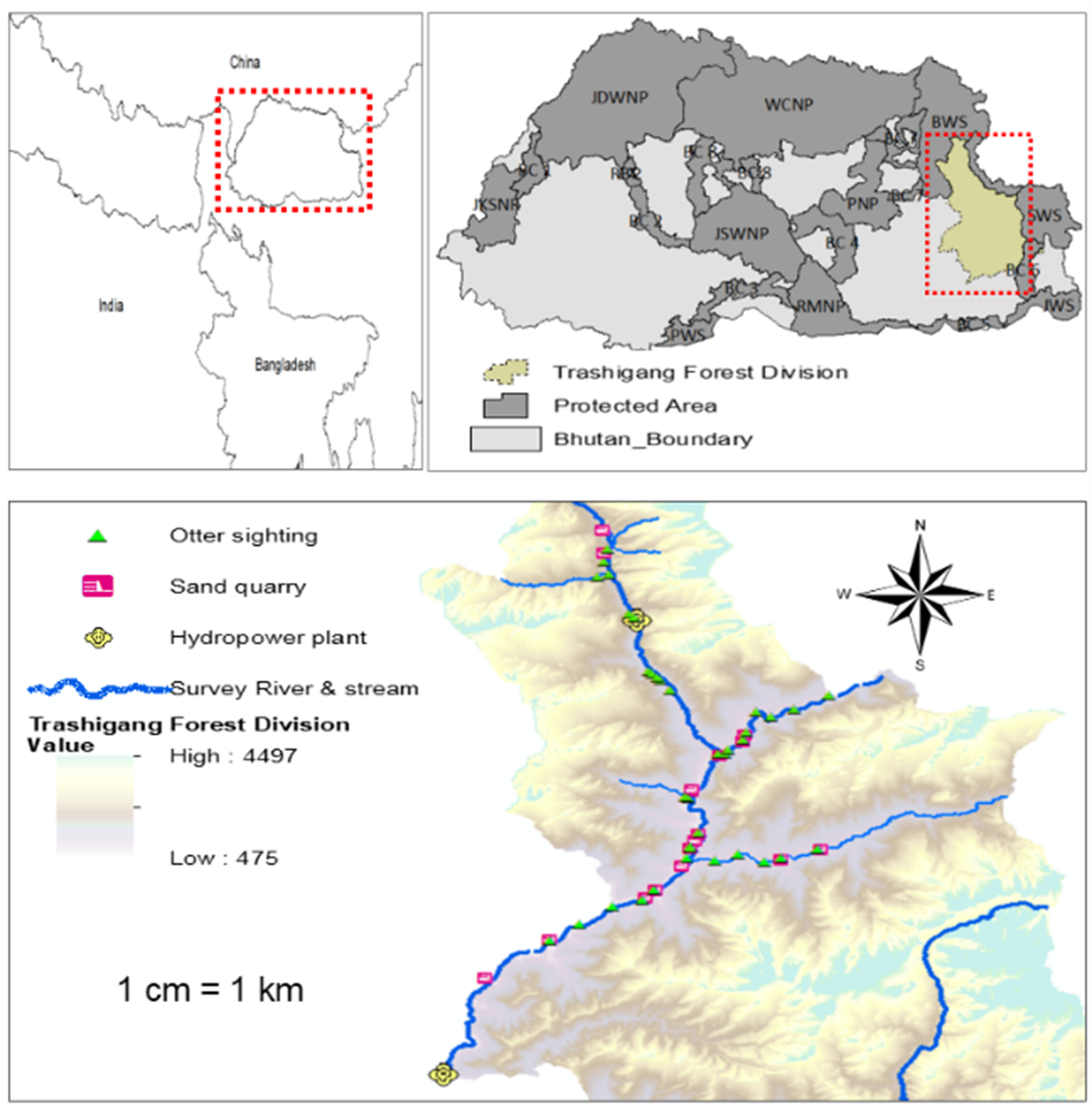
Data Collection
During an extensive fishing patrolling, incidental rapid biodiversity surveys, site inspection, environmental impact assessments and white-bellied heron (Ardea insignis) survey along upper Drangmechu River and Kholongchu River, opportunistic observation data was collected from 2018 to 2023, including a direct sighting and indirect signs of otters. Otter specific field surveys were also conducted on foot led by the first author across two rivers and tributaries (Fig. 2) to collect evidence of the presence of otters. The otter specific survey was undertaken during pre- and post-monsoon seasons. Survey team walked both sides of the banks of the rivers and their tributaries, and searched for otter presence/absence sign, all within an elevation range of 450 to 1850 masl.
Otter presence indirect sign (scats, latrine sites, tracks, dens and grooming sites), direct sighting, locations and important habitat variables (river bankside condition, water current and depth, bank slope and gradient, escape cover distance, basking and grooming sites, presence of logs, sandy bank and surrounding vegetation type) were recorded. In addition, potential threats and disturbances signs were also recorded where considered potentially important for otters.
Two infrared camera-traps UWayTM (Uway Outdoors, Norcross, Georgia, U.S.A.) were also installed opportunistically along the Kholongchu sub-basin in March, 2022, targeted to capture an image of otter. The camera traps were set to function 24 hours per day with five second time lapse between consecutive photographs, and three shots per trigger. No attractants, lure or bait was used. The geo-coordinates and elevation of both indirect and direct signs observed, and camera trap locations, were recorded using GPS-Garmin e-Trex® 30 (Garmin International Inc., Olathe, Kansas, U.S.A.) device set to WGS 84 datum.
To get an additional inputs and information about otters in the study area, we also consulted in local villagers, fishers and forestry personnel of the Trashigang Forest Division.
Identification of Sign and Otter Species
Otter scats were identified by the presence of fish bones, scales and a fishy odor. Latrines, displaying multiple scat, trails and tracks, were usually found at sandy areas and near large boulders near the water’s edge. Tracks were identified by a round impression of five toes and faint webbing marks on mud and sand along riverbank; only positively identified otter tracks were recorded. Melissa Savage (PhD), University of California, Los Angeles, USA was consulted for correct species identification.
RESULTS
Indirect Otter Signs
Otter scats, latrine sites, tracks or trail and dens were recorded along the Kholongchu and upper Drangmechu Rivers, and their tributaries such as Dongdichhu and Tshergom stream in Trashiyangtse District, and Gamri River in Trashigang District. A total of 99 indirect signs were recorded: scats= 61 with 26 fresh and 35 old to very old, tracks= 34, slide or grooming= 2 and den = 1.
The survey recorded otter tracks distinctly displayed on mud and sandy banks (Fig. 3). Otter slide and grooming sites were also recorded from the sandy bank of the Kholongchu River, upper Drangmechu River and Gamri River. Cave, crevices and well-vegetated sandy banks were used for the otter den along kholongchu river bank in Betshateng Koncholing under Khamdang block, TrashiYangtse District. In the survey, fish (Schizothorax richardsonii) carcass remains (n= 1) with bite marks were recorded, with abdominal or the tail portions left discarded by the otters (Fig. 6b) likely because otters do not prefer the tail part of the fish, which lacks fleshy meat.
Among the otter indirect sign recorded, scats and latrine sites were most often observed on the large flat stones and boulders at the edge or in the middle of the river where banks were flat and the water current slow, sluggish or static. Otters also used drift logs and sandy banks along the water edges for feeding and defecation. Otter scats were found of different sizes, from large and narrow, with fish and crustacean remains and a distinctively fishy odour (Fig. 4).
Direct Sightings
Repeated sightings of groups of 2 to 5 otters were seen at multiple locations along the Drangmechu and Kholongchu Rivers, and their tributaries, including the Gamri River, Dongdhi chu and Tshergom stream. Photographic evidence of Smooth-coated otters (Fig. 5) was also recorded, during activities such as swimming, prey hunting and feeding, sun basking and grooming along these rivers and tributaries. A small-clawed otter with its prey (Fig. 6a) was opportunistically photographed from upper Kholongchu River in 2018 by forestry personnel of Bumdeling Wildlife Sanctuary, a record almost 10 km away from the town of Yangtse. In 2020, two small-clawed otter individuals were also spotted along the Kholongchu River below the town of Yangtse.

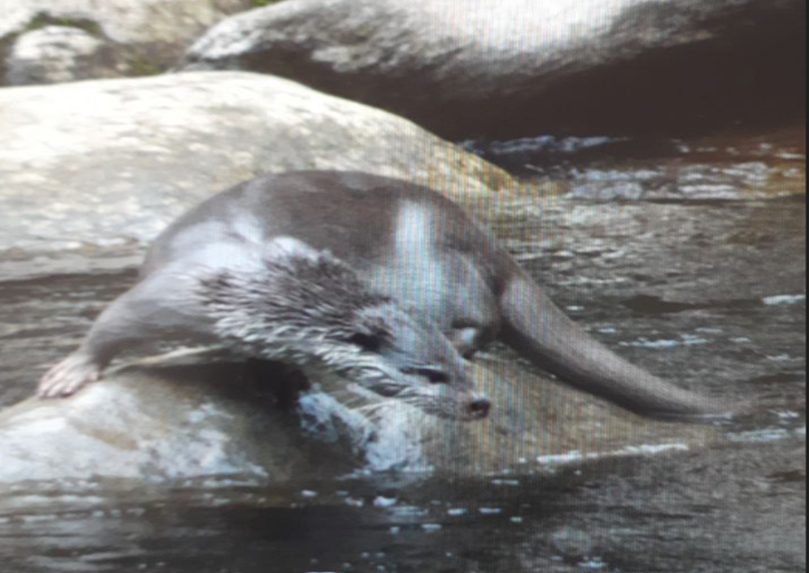
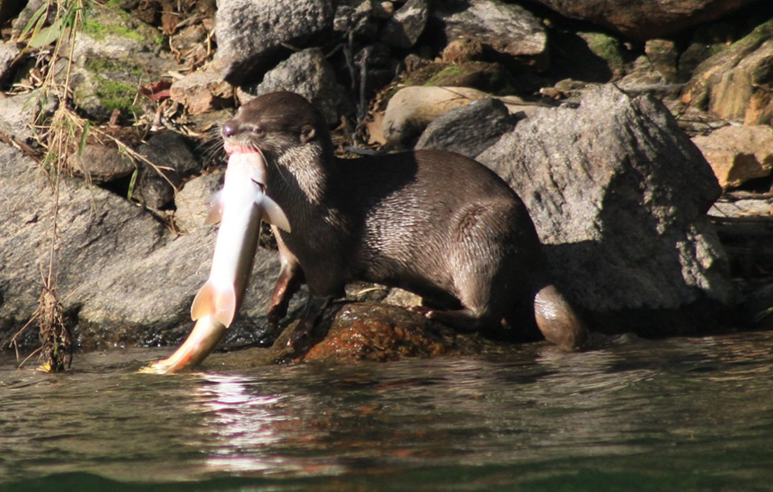
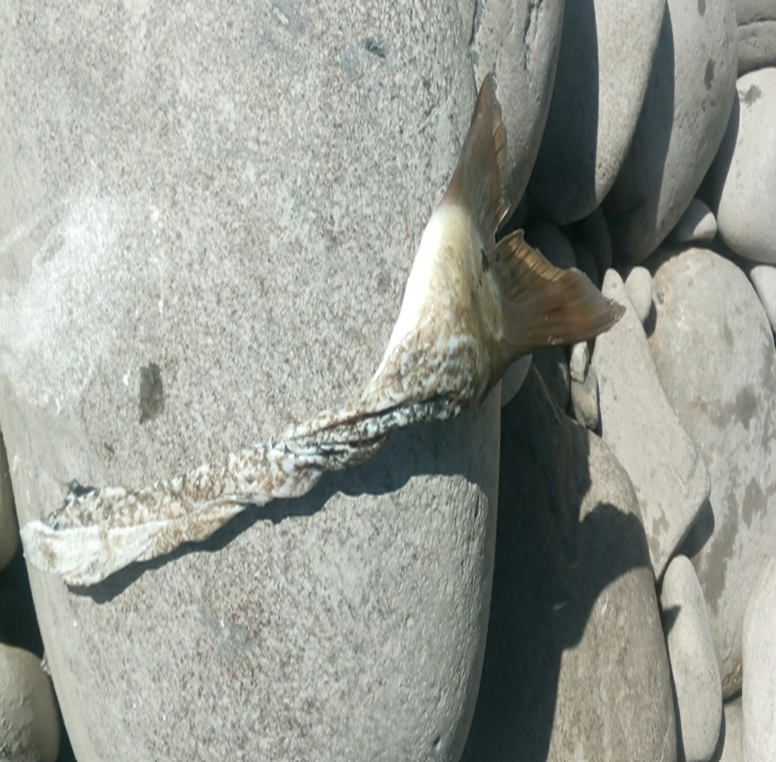
In November 2023, the forestry personnel of Radhi Forest Range rescued an injured adult Eurasian otter (Fig. 8a) from the Gamri River watershed, which was released and later found dead. Our survey team also recovered a Eurasian otter pelt in 2018 from a fisher's house in the town of Doksum, Trashiyangtse (Fig. 7). During a detail investigation, it was learned that the otter pelt was recovered from bank of lower Kholongchu River, perhaps killed by the high flow of the monsoon river. One of the fisherman also reported that a juvenile otter was killed by cow herder and his dog at the Tshergom stream in Trashiyangtse. A similar incidence was also anecdotally reported from the town of Yangtse, a dead juvenile otter in Berzam chhu stream above Chorten Kora, suspected to be killed by the local feral dogs.
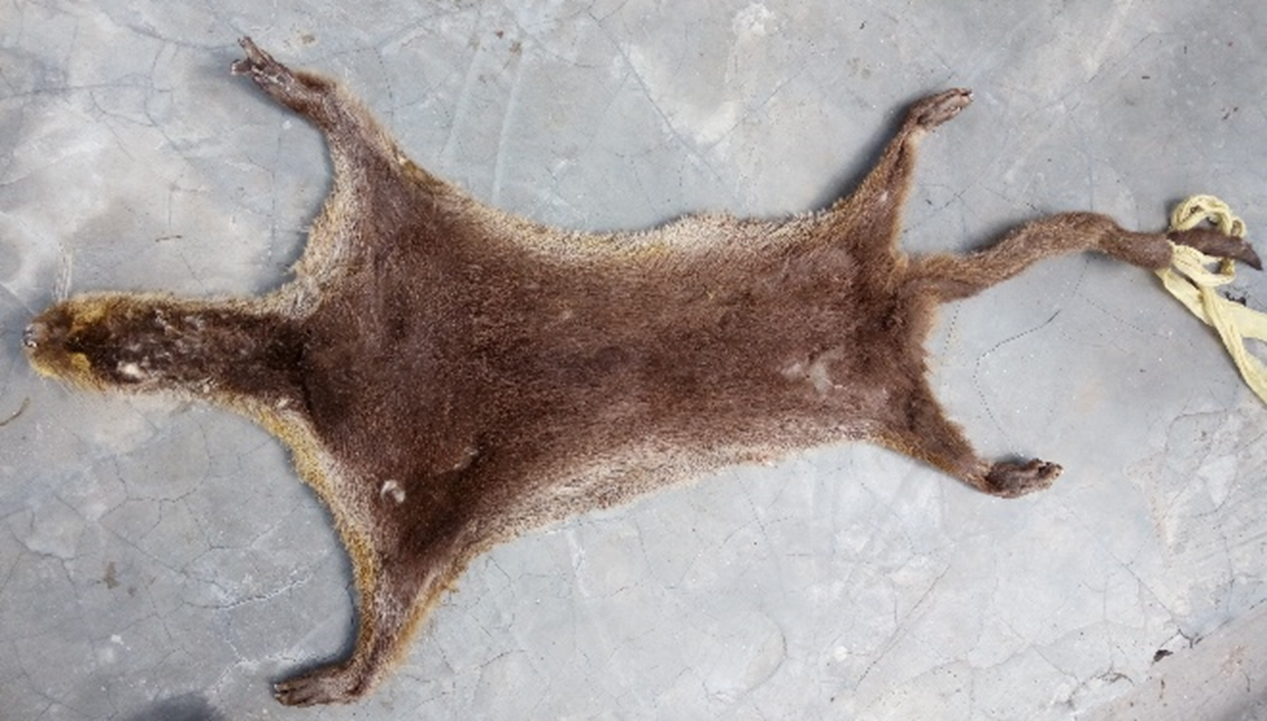
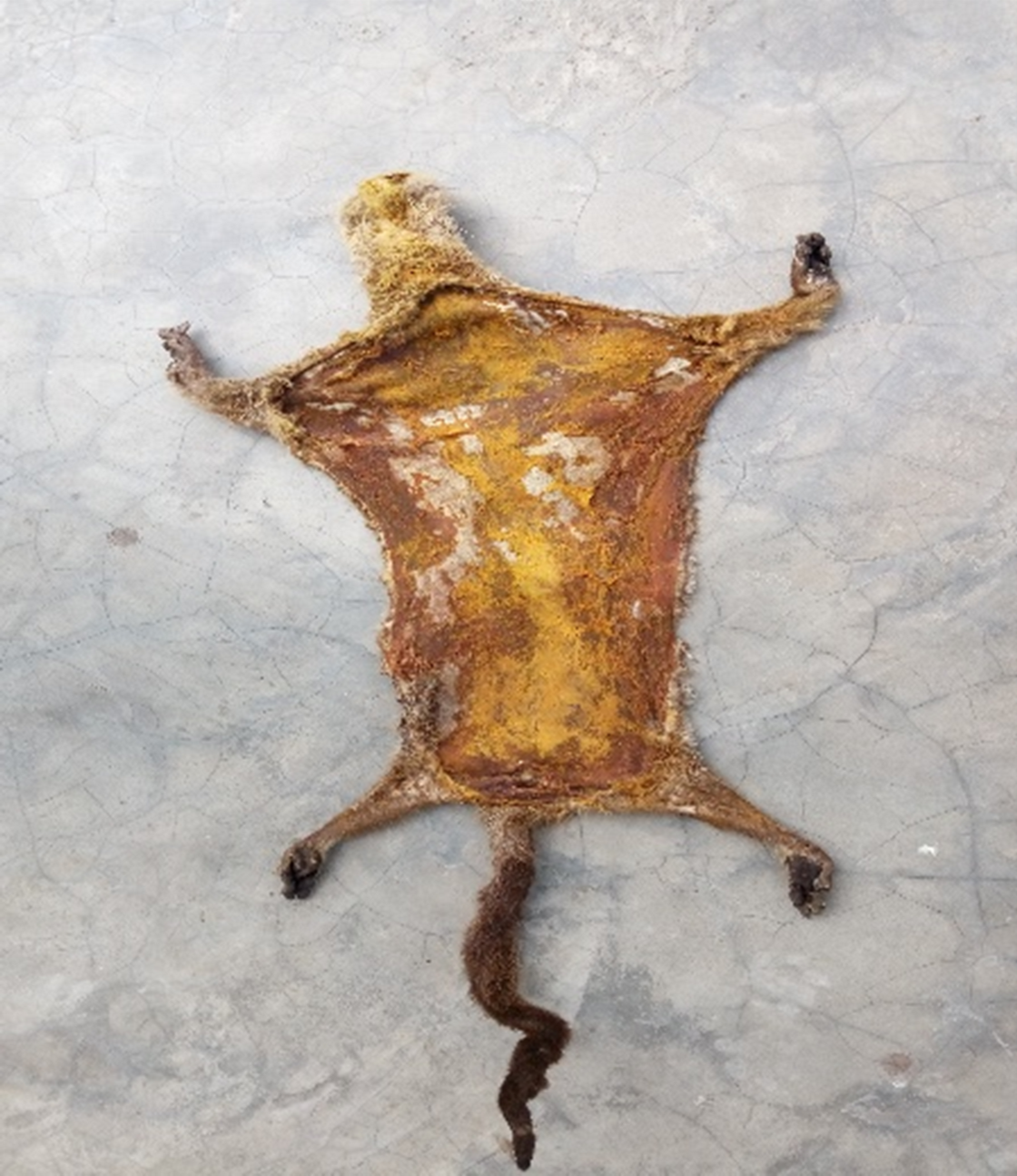
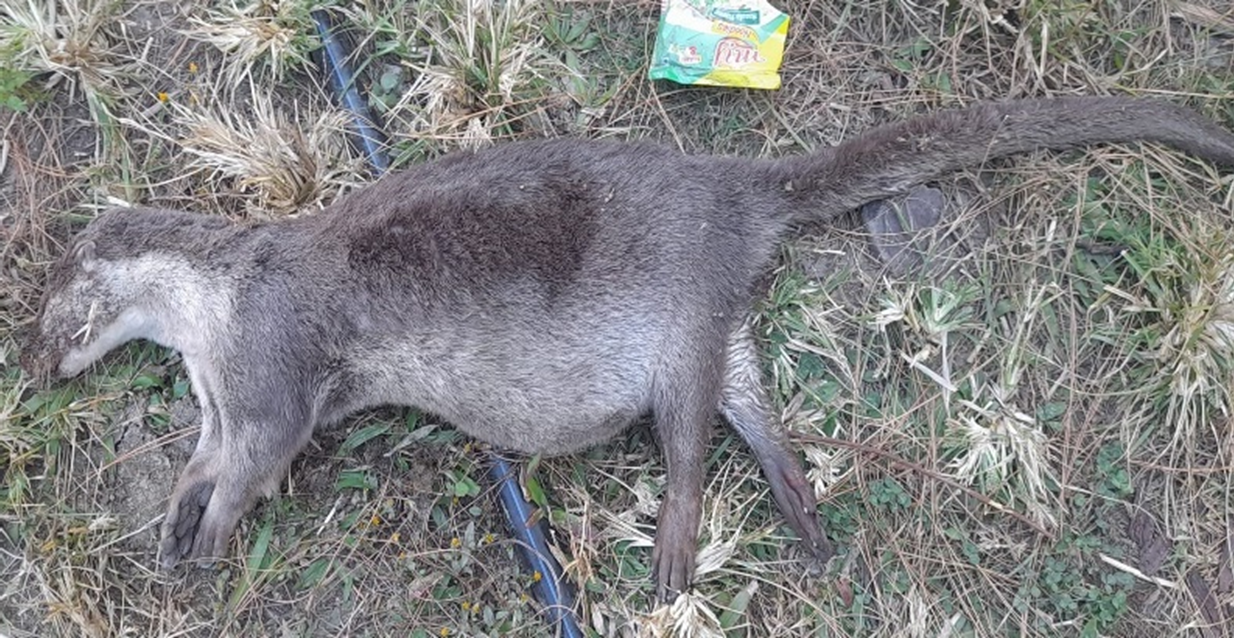
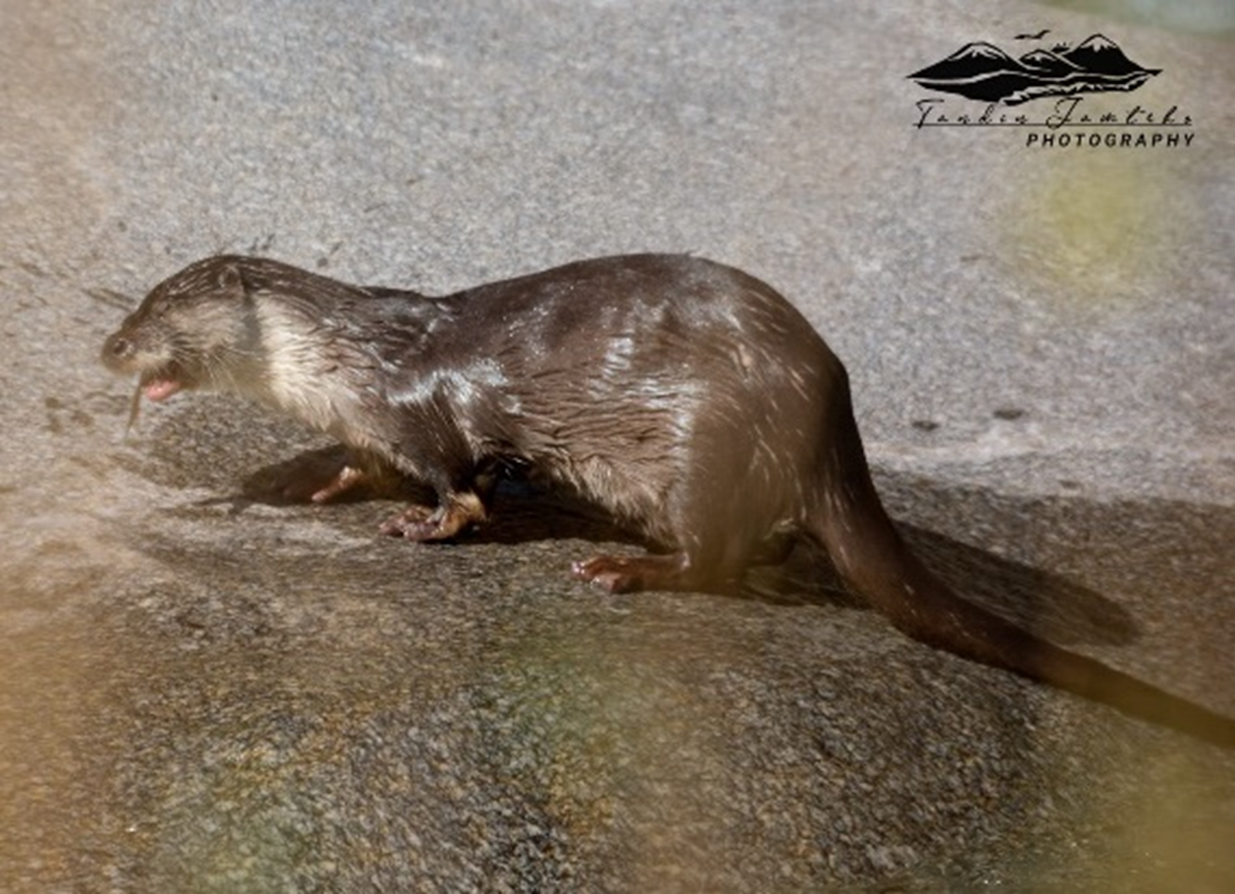
Camera trap and Social Evidence
Remote camera traps were set in the field for 35 days but no images of otters were captured. However, multiple fresh otter tracks and scats were observed at the camera locations. Other wildlife fauna, viz. Leopard cat (Prionailurus bengalensis), Yellow-throated Marten (Martes flavigula), Arunachal macaque (Macaca munzala), Himalayan goral (Nemorhaedus goral), rodents and birds were repeatedly recorded from two camera trap locations.
Informal interviews and discussions were conducted with local communities, fishers, and forestry personnel of Trashigang Forest Division, and many thought that otter species were present; however, it is unclear whether these animals were correctly identified. Interviewed fishers reported frequent interections with otters while fishing along the rivers and tributaries. A few fishers mentioned that they had fishing nets damaged by otters and they had retaliated and killed otters often in the past.
Habitat Characteristics and Vegetation Types
Kholongchu sub-basin (Fig. 9b) runs primarily through a narrow valley, with a fast current and rapids; in some sections it passes through a gentle plain where river runs with a slow current. The banks of the river consists of a jumble of large boulders and stones, with sections of sandy banks scattered intermittantly. The riparian vegetation observed along the sub-basin and its tributaries are dominated by broadleaved forests, viz. Cordia obliquum, Aphanamixis polystachya, Garcinia sopsopia, Altinga excelsa, Sloanea tomentosa, Trema spp., Daphniphylum himalayanse, Neolitsea spp., Acer oblongum, Schima wallichia, Schima khasiana, Symplocus spp., Alnus nepalensis, Cinnamomum spp., Lindera spp., Carpinus betulas, and Quercus griffithii.
Unlike the Kholongchu sub-basin, the upper Drangmechu basin (Fig. 9a) runs through a gentle gradient from fast to gentle and slow. The river basin banks consist of a jumble of boulders and stones with large sandy banks scattered intermittantly. The vegetation types observed along the upper Drangmechu River and its tribuatries are mostly dominated by xerophytes such as Pinus roxburghii, Cycus spp., Cassia fistula, Acacia spp., and, in some locations by broadleaved tree species such as Dalbergia spp., Erythrina arborescens, Bombax ceiba, Diploknema butyracea, and Duabanga spp.
Vegetation common to both the river basins include Syzygium cuminii, Bischofia javanica, Radermachera sinica, Bauhinia spp., Mallotus phillipensis, Engelhardia spicata, Zizziphus spp., Clerodendrum glandulosum, Macaranga denticulata, Zanthoxylum spp., Ficus spp., Albizzia spp., Rhus spp., Phylanthus emblica, and Quercus gluaca.
Disturbances and Threats to Otters
Potential disturbances and threats to otters were observed along both the river basin and their tributaries. Notable anthropogenic disturbances include sand dredging and other river material collection, illicit fishing, hydropower construction and unlawful dumping of non-degradable waste into rivers. One sand dredging site and numerous small collection points along the Kholongchu River stretch were observed. Similarly, more than eight commercial sand dredging sites and many small collection points were observed along the Drangmechu River (Fig. 10), as well as sand collection and stone quarry points along the Gamri River.
Illegal fishing is also observed at 22 points along both river basin and their tributaries including illegal fishing sign and gear such as hooks, nets, and other signs, evidence of the severe competition and conflict that otters face from the fishing by humans (Fig. 11).
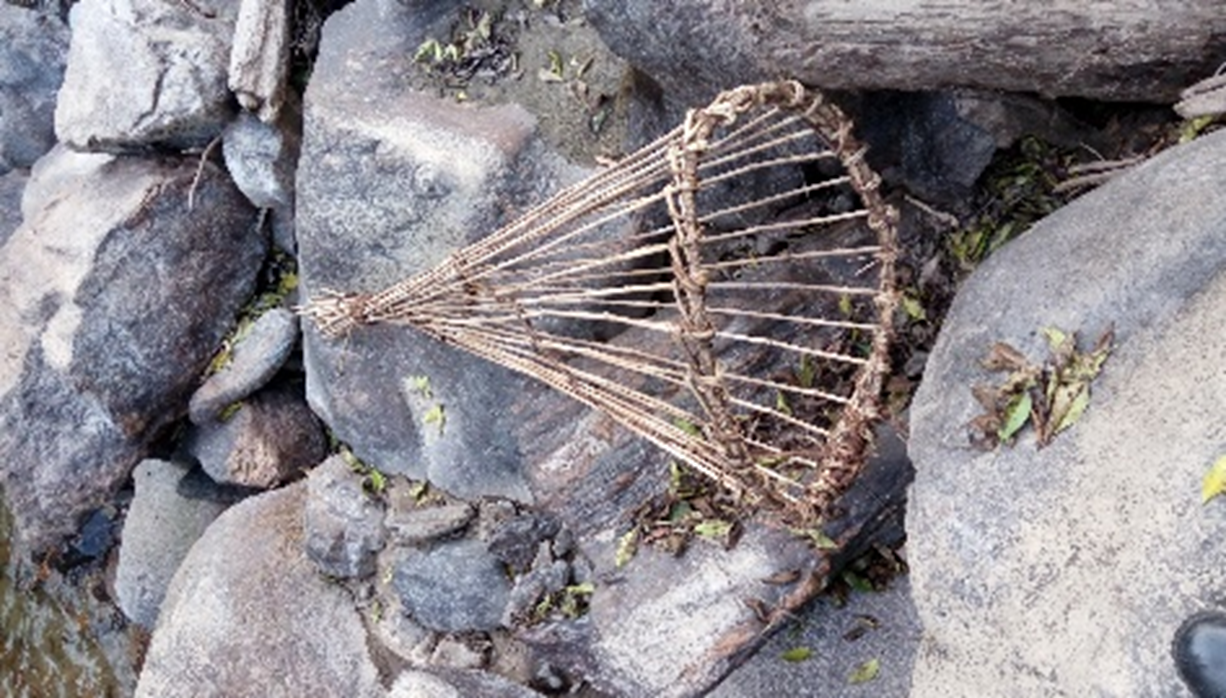
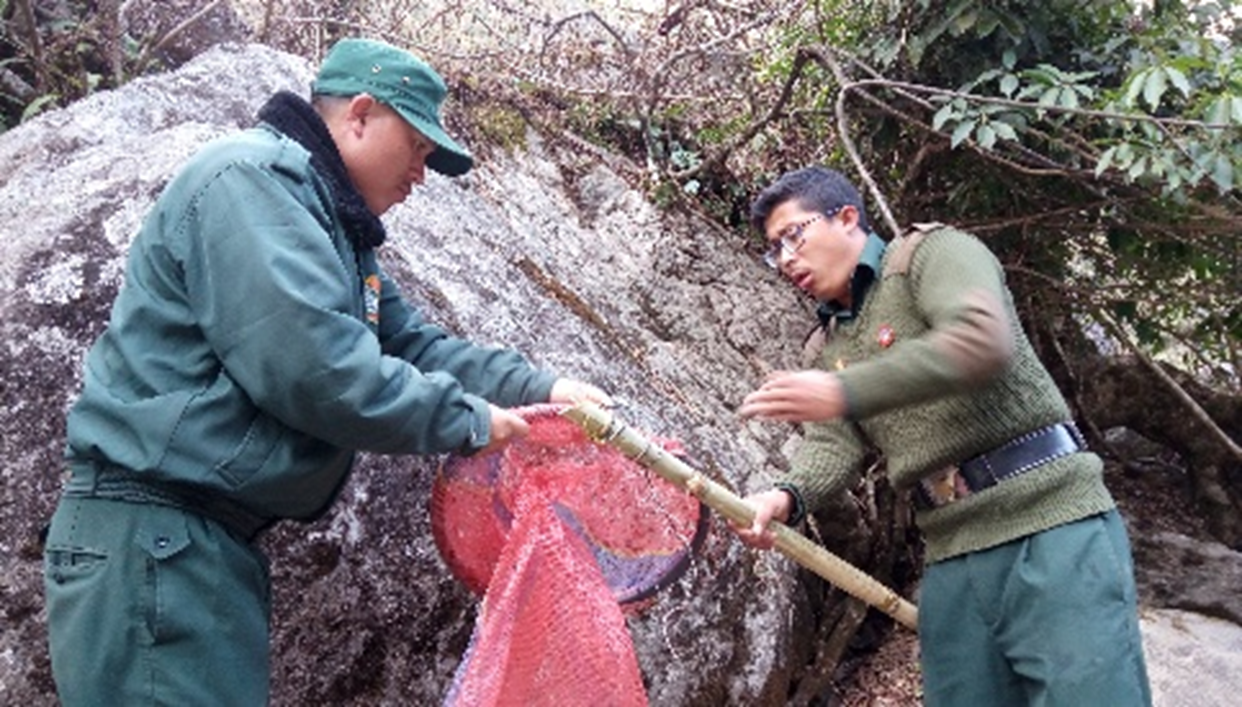
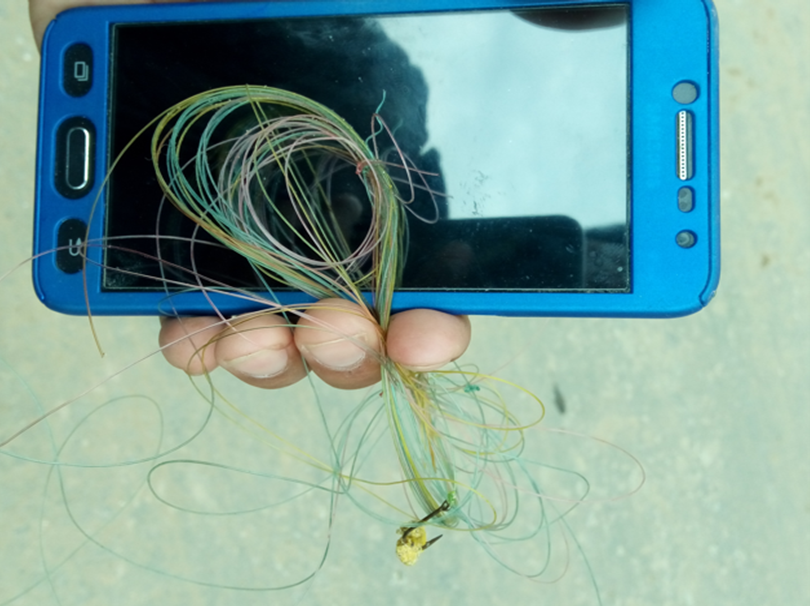
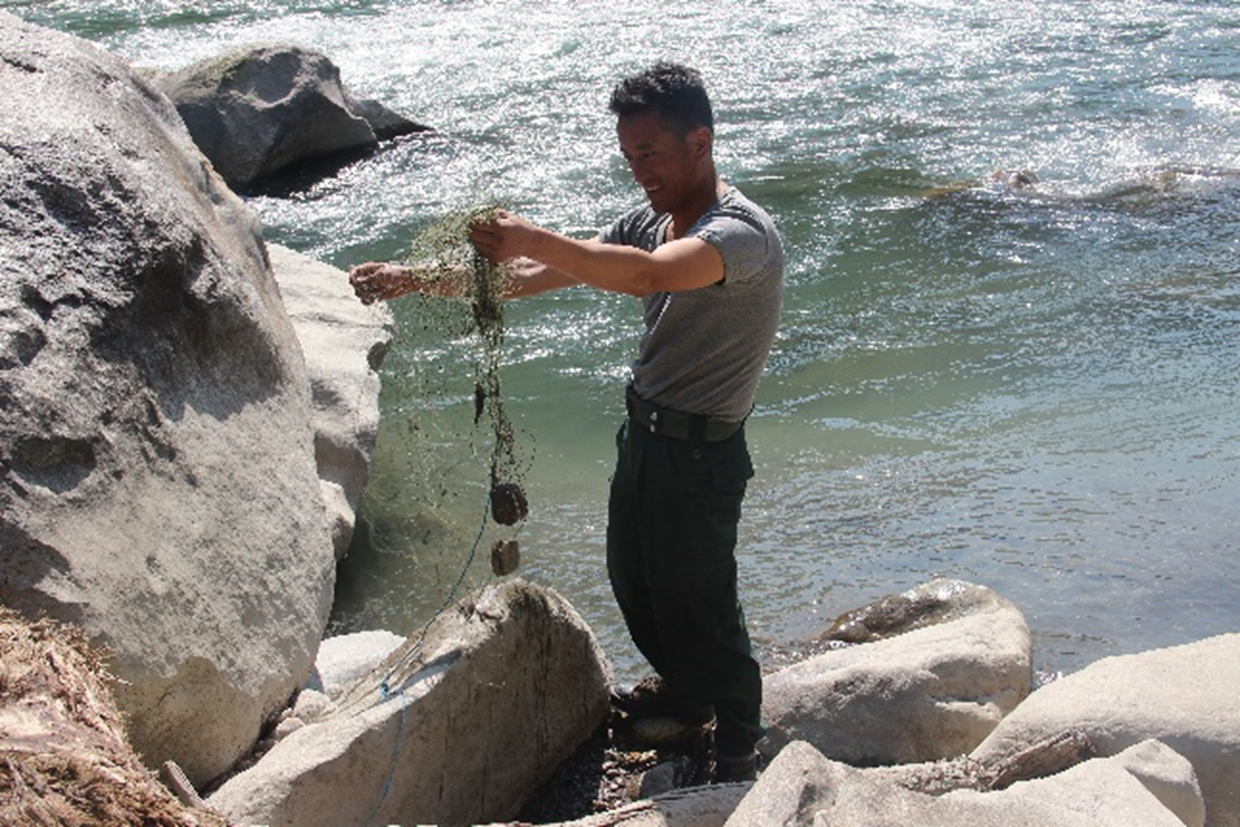
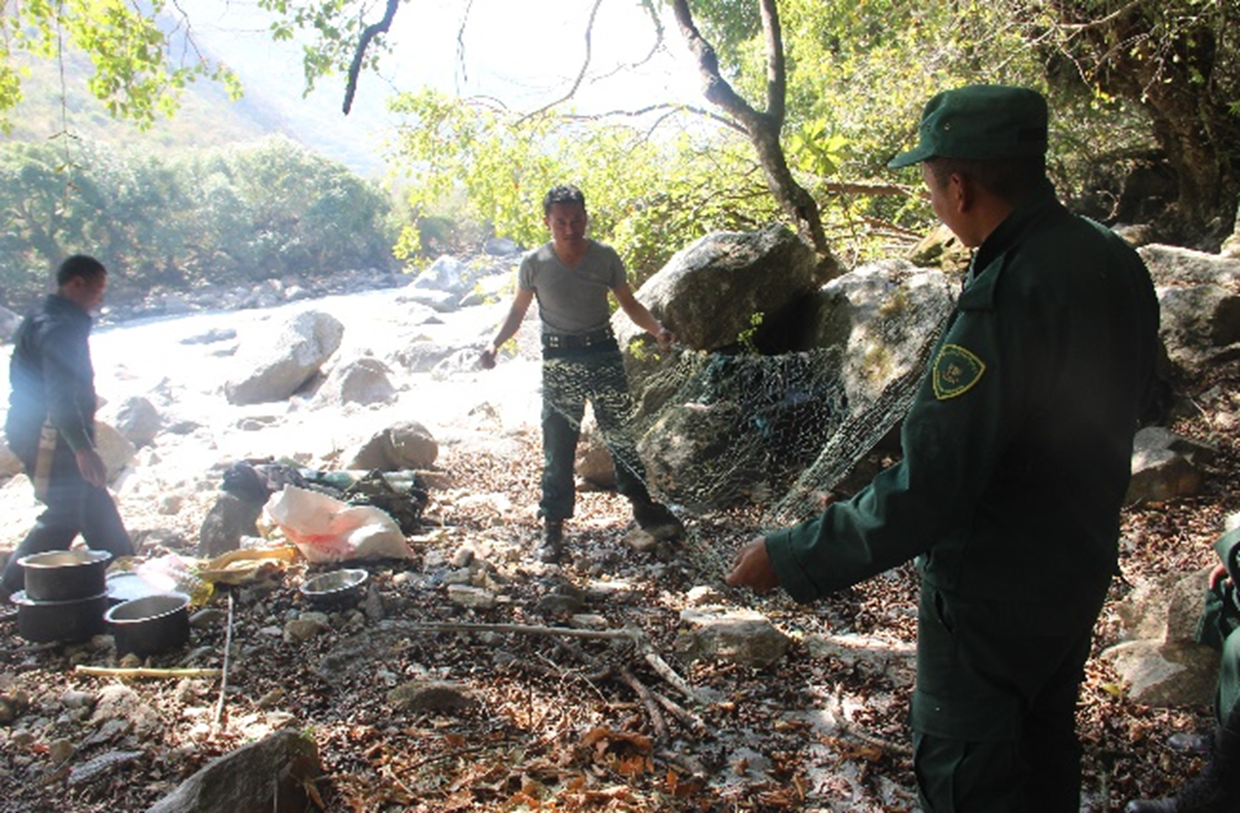
Another major threat will be habitat fragmentation and degradation caused by the construction of the 600-megawatts Kholongchu hydroelectric power amenity. The project will construction a large dam on the Kholongchu River and a small diversion tunnel at its tributary, the Bramlangchu stream. Once the construction of dam and tunnel commences, a large portion of river and stream will be diverted into the tunnel, severely disrupting aquatic ecosystem dynamics (Khatiwara and Bhutia, 2020, Figure 12).
DISCUSSION
This is the first preliminary survey effort on otters in the eastern Bhutan, despite the fact that the region, including the Kholongchu River and the upper Drangmechu River, and their tributaries inside Trashigang Forest Division landscape, have extensive suitable habitat for otters. This study reveals photographic evidence of presence of three otter species in the region, the Smooth-coated otter, Small-clawed otter and Eurasian otter. The survey found multiple otter sign such as tracks, scats, latrines and dens in sites with vegetation cover, along sandy river banks with large boulders, and with minimal human disturbances (Chettri and Savage, 2014). Based on the survey findings, all three otter species appear to inhabit the river systems, with some overlap their habitat use, thus suggesting likely coexistence or sympatric behaviour of these species. This survey did not study otter behaviour traits or prey base, nor otter abundance and population status. Therefore, further systematic studies are needed to confirm the abundance and population status of three otter species in the region.
CONCLUSION
Across South Asia and the Himalayan region, otter populations are dwindling and subject to intensifying pressure of expanding human population, fragmentation of wetland habitat, poaching, loss of adequate prey base, pollution, contamination of waterways, and construction of hydro power plants (Duplaix and Savage, 2018). Otters in eastern Bhutan and elsewhere in the country are significantly impacted by the construction of large hydroelectric plant facilities, as they are throughout the Himalayas (Foster-Turley et al., 1990; Chettri and Savage, 2014). However, no studies have yet been conducted on this issue, and the greatest threat to otter species in Bhutan is arguably the current and planned construction of multiple hydroelectric power facilities (Chettri and Savage, 2014). In addition, the impact on otter populations of human activities such as large-scale sand mining and quarrying, river bed material collections, dumping of waste and extensive fishing along the river basin deserve further investigation.
A fuller understanding of the distribution and status of otters in the study region and throughout Bhutan would enable informed conservation decisions. Lack of such information will hinder suitable conservation efforts and lead to further declines in their populations. Presence-absence data is crucial for framing a species conservation strategy. This study lays a foundation for future research on otter species in eastern Bhutan, to better understand their status, distribution, and threats and to plan for their long-term conservation in a highly biodiverse region of Bhutan.
Acknowledgements: We want to thank Mr. Karma Leki, Chief Forestry Officer of Trashigang Forest Division, Department of Forest and Park Services, for his continuous support and motivation. We are also indebted to the staff of Trashigang Forest Division for information sharing. Mr. Rinchen Choda of Toetsho Beat, Mr. Phurpa Wangdi of Radhi Range and Mr. Tshering Choephel of Bumdeling Wildlife Sanctuary, is also well acknowledged for allowing us to use their photographs of Smooth-coated otter, Eurasian otter and Small-clawed otter. We express our sincere gratitude to Melissa Savage (PhD), University of California, Los Angeles, USA for correct species indentification. Further, we are extremely grateful to all the anonymous reviewers for their comments and suggestions in improving the quality of this manuscript.
REFERENCES
Basnet, A., Ghimire, P., Timilsina, Y.P. and Bist, B.S. (2020). Otter research in Asia: Trends, biases and future directions. Global Ecology and Conservation, 24: 1-13. https://doi.org/10.1016/j.gecco.2020.e01391
Bhattacharya, M., Watham, T. and Gopi, G.V. (2019). Photographic records of Eurasian Otter (Lutra lutra Linnaeus, 1758) from Nyamjang Chu River, Arunachal Pradesh, India. IUCN Otter Spec. Group Bull. 36(2): 103 – 109. https://www.iucnosgbull.org/Volume36/Bhattacharya_et_al_2019.html
Borker, A., Gogi, K., Krupa, H., Savage, M. and Bhardwaj, N. (2022). Otter survey in Pakke Tiger Reserve, Arunachal Pradesh, Eastern Himalayas of India. IUCN Otter Spec. Group Bull. 39(1): 29-38. https://www.iucnosgbull.org/Volume39/Borker_et_al_2022.html
Chettri, P. and Savage, M. (2014). A distribution survey for otters along a river in central Bhutan. IUCN Otter Spec. Group Bull., 31(2):65-74. https://www.iucnosgbull.org/Volume31/Chettri_Savage_2014.html
De Silva, P.K. (2011). Status of Otter Species in the Asian Region Status for 2007. In: Gutleb, A.C., Han, S.-Y., Duplaix, N. (eds.) Proceedings of Xth International Otter Colloquium, Hwacheon, South Korea. IUCN Otter Spec. Group Bull. 28A: 97-107. https://www.iucnosgbull.org/Volume28A/de_Silva_2011.html
Duplaix, N. and Savage, M. (2018). The Global Otter Conservation Strategy. IUCN/SSC Otter Specialist Group, Salem, Oregon, USA. https://www.google.com/url?sa=t&source=web&rct=j&opi=89978449&url=https://www.otterspecialistgroup.org/osg-newsite/wp-content/uploads/2018/12/IUCN-Otter-Report-DEC%252012%2520final_small.pdf&ved=2ahUKEwiK5Ijf6PyIAxVzZ0EAHUnaM5QQFnoECBkQAQ&usg=AOvVaw14I5cyo4eToaPOqUFaShqS
Foster-Turley, P., Macdonald, S. M. and Mason, C.F. (1990). Otters: An action plan for their conservation. IUCN/Otter Specialist Group, Gland. 126 pp. https://doi.org/10.2305/IUCN.CH.1990.SSC-AP.3.en
Gowtham, R., Sharma, K. and Sathishkumar, S. (2022). Smooth-Coated Otter (Lutrogale perspicillata) preys on invasive fishes in Vaduvoor Bird Sanctuary, Tamil Nadu, Southern India: Can Otters be Potential Bio-Controllers? IUCN Otter Spec. Group Bull., 39(2): 73 – 80. https://www.iucnosgbull.org/Volume39/Gowtham_et_al_2022.html
Gupta, N., Tiwari, V., Everard, M, Savage, M., Hussain, S.A., Chadwick, M.A., Johnson, J.A., Nawab, A. and Belwal, V.K. (2020). Assessing the distribution pattern of otters in four rivers of the Indian Himalayan biodiversity hotspot. Aquatic Conserv: Marine and Freshw. Ecosyst, 30: 601–610 https://doi.org/10.1002/aqc.3284
Gyeltshen, J. and Dorji, C. (2015). Sighting of Asian small-clawed otter: A new small mammal record from Thrumshingla National Park, Bhutan. Small Mammal Mail-Bi-annnual newsletter of CCINSA & RISCINSA. 7(1): 20-21. https://www.calameo.com/books/00155229710dc0b780663
Khatiwara, S. and Bhutia, K.C. (2020). A distribution survey for otters in Sikkim, India. IUCN Otter Spec. Group Bull. 37(4): 212 – 218. https://www.iucnosgbull.org/Volume37/Khatiwara_Bhutia_2020.html
Koirala, B.K., Jamtsho, k., Wangdi, P., Tshering, D., Wangdi, R., Norbu, L., Phuntsho, S., Lhendup, S. and Nidup, T. (2021). Diversity and distribution of snakes in Trashigang Territorial Forest Division, eastern Bhutan. Journal of Threatened Taxa, 13(1): 17455–17469. https://doi.org/10.11609/jott.6835.13.1.17455-17469
Medhi, K., Chakraborty, R. and Upadhyay, J. (2014). Photographic Record of Smooth-Coated Otter (Lutrogale perspicillata Geoffroy 1826) in Nyamjang Chu Valley, Arunachal Pradesh, India. IUCN Otter Spec. Group Bull. 31 (2): 75 - 79 https://www.iucnosgbull.org/Volume31/Medhi_et_al_2014.html
Myers, N., Mittermeier, R. A., Mittermeier, C. G., Da Fonseca, G.A. B. and Kent, J. (2000). Biodiversity hotspots for conservation priorities. Nature, 403(24): 853–858. https://doi.org/10.1038/35002501
Naidu, R., Trivedi, K., Mandavia, A., Singh, S., Bharos, A.M.K., Jadeja, S. and Kshirsagar, N. (2022). Distribution of the Asian Small-Clawed Otter (Aonyx cinereus) in Chhattisgarh, India. IUCN Otter Spec. Group Bull. 39(3): 171 – 178. https://www.iucnosgbull.org/Volume39/Naidu_et_al_2022.html
NCS. (2023). Annual Biodiversity Monitoring Grids (BMG) Report for Divisional Forest Office, Trashigang. Department of Forests & Park Services, Thimphu, Bhutan. 93 pp.
Norbu, L., Thinley, P., Jamtsho, N., Dorji, L., Tenzin, P., Wangchuk, T., Lhendup, U., Dorji, P., Dorji, Z., Jamtsho, K., Dorji, T., Jamtsho, T., Lodey, S. and Dechen, U. (2022). Diversity of hawkmoths in Tashigang Forest Division, with new faunistic records for Bhutan. Journal of Animal Diversity, 4(3): 10–22. http://dx.doi.org/10.52547/JAD.2022.4.3.3
Norbu, L., Thinley, P., Wangchuck, T., Dechen, U., Dorji, L., Choephel, T. and Dorji, P. (2021). On the high bird diversity in the non-protected regions of Trashiyangtse District in Bhutan. Journal of Threatened Taxa, 13(9): 19274–19292
https://threatenedtaxa.org/index.php/JoTT/article/view/6843
Olson, D. M. and Dinerstein, E. (2002). The Global 200: Priority ecoregions for global conservation. Annals of the Missouri Botanical Garden, 89: 199–224. https://doi.org/10.2307/3298564
Savage, M. (2022). Otters in Northeast India: A Review of the sparse available information. IUCN Otter Spec. Group Bull. 39(2): 81 – 89. https://www.iucnosgbull.org/Volume39/Savage_2022.html
Tobgay, S., Dechen, U., Tobgay, S., Norbu, L., Dema, C., Dorji,T., Dorji,T., Lhendup, U., Rangdol, N. and Jamtsho, K. (2022). Feasibility Assessment Report. Designating Biological Corridor (BC) to connect Sakteng Wildlife Sanctuary and Bumdeling Wildlife Sanctuary. Divisional Forest Office, Trashigang. Department of Forest and Park Services, Bhutan.
https://drive.google.com/file/d/1MfByCt7VsqvwsSnvfspGpKO4Qxvws5Nn/view?pli=1
Wangchuk, T., Rai, S. and Gyeltshen, C. (2021). Habitat preference of freshwater fishes along the Gamri river, Trashigang, Bhutan. Biodiversitat and Naturausstattung im Himalaya, VII: 119-126. https://biodiversity.bt/biodiv/content/documents/59b094f9-b62f-4d55-b47a-4f085026b0d3/167b772a765f4309880ee8511cf25cc2.pdf
Wangchuk, T., Thinley, P., Tshering, K., Tshering, C., Yonten, D. and Pema, B. (2004). Field guide to the mammals of Bhutan. Department of Forests & Park Services, Ministry of Agriculture, Royal Government of Bhutan. 182 pp. ISBN: 9789993662006.
Résumé: Enquête sur les Loutres des Rivières du Kholongchu et du Haut Dangmechu, Situées à l’Est du Bhoutan
Les différentes espèces de loutres sont en déclin dans leur aire de répartition en Asie. Il existe peu d’informations disponibles sur la présence des loutres au Bhoutan. Cette étude documente la présence de trois espèces de loutres à savoir la loutre à pelage lisse (Lutrogale perspicillata), la loutre cendrée (Aonyx cinereus) et la loutre eurasienne (Lutra lutra), dans le paysage de la division forestière de Trashigang, à l’est du Bhoutan. Plusieurs techniques ont été utilisées afin de documenter la présence des loutres, notamment des relevés à l’aide de pièges photographiques, des indices de présence, l’observation directe, des preuves photographiques fiables, des spécimens trouvés et la consultation publique. Les perturbations de l’habitat, notamment l’extraction de sable et les carrières, la pêche non réglementée et la construction de turbines, ont été identifiées comme des menaces importantes pour les loutres dans la région étudiée. D’autres enquêtes systématiques sur les loutres sont nécessaires dans la région et dans d’autres parties du pays pour réaliser une évaluation précise de la population, comprendre les menaces et développer des stratégies de conservation efficaces pour la protection des différentes espèces de loutres au Bhoutan..
Revenez au dessus
Resumen: Relevamiento de Nutrias en los Ríos Kholongchu y Drangmechu Superior, Bhutan Oriental
Las especies de nutrias están declinando en toda su área de distribución en Asia. Se dispone sólo de escasa información sobre la presencia de nutrias en Bhutan. Este estudio documento la presencia de tres especies de nutria, la Nutria Lisa ((Lutrogale perspicillata), la Nutria de Uñas Pequeñas (Aonyx cinereus) y la Nutria Eurasiática (Lutra lutra); en el paisaje de la División Forestal Trashigang, en Bhutan oriental. Se usaron múltiples técnicas para documentar la presencia de nutrias, incluyendo relevamiento con cámaras-trampa, relevamiento de signos, avistamiento directo, evidencia fotográfica confiable, hallazgo de especímenes, y consulta pública. Se identificaron como amenazas significativas a las nutrias en la región de estudio, los disturbios de hábitat incluyendo extracción de arena y canteras, pesca no regulada y construcción de represas hidroeléctricas. Se necesitan ulteriores relevamientos sistemáticos de nutrias en la región y en otras partes del país, para realizar una evaluación poblacional certera, comprender las amenazas, y desarrollar estrategias efectivas de conservación para la protección de las especies de nutrias en Bhutan.
Vuelva a la tapa
फिर से शुरू करें: पूर्वी भूटान की खोलोंग्चू और ऊपरी ड्रांगमेचू नदियों में ऊदबिलावों का एक सर्वेक्षण
एशिया में अपने वितरण क्षेत्र में ऊदबिलाव प्रजातियाँ घट रही हैं। भूटान में ऊदबिलाव की मौजूदगी के बारे में बहुत कम जानकारी उपलब्ध है। यह अध्ययन पूर्वी भूटान में ट्रैशिगांग वन प्रभाग के परिदृश्य के अंदर तीन ऊदबिलाव प्रजातियों, चिकने-लेपित ऊदबिलाव, छोटे पंजे वाले ऊदबिलाव और यूरेशियन ऊदबिलाव की उपस्थिति का दस्तावेजीकरण करता है। ऊदबिलाव की उपस्थिति का दस्तावेजीकरण करने के लिए कई तकनीकों का उपयोग किया गया, जिसमें कैमरा ट्रैप सर्वेक्षण, संकेत सर्वेक्षण, प्रत्यक्ष दृष्टि, विश्वसनीय फोटोग्राफिक साक्ष्य, पाए गए नमूने और सार्वजनिक परामर्श शामिल हैं। अध्ययन क्षेत्र में रेत खनन और खदान, अनियमित मछली पकड़ने और जलविद्युत निर्माण सहित आवास संबंधी गड़बड़ी को ऊदबिलावों के लिए महत्वपूर्ण खतरे के रूप में पहचाना गया। सटीक जनसंख्या मूल्यांकन करने, खतरों को समझने और भूटान में ऊदबिलाव प्रजातियों की सुरक्षा के लिए प्रभावी संरक्षण रणनीति विकसित करने के लिए क्षेत्र और देश के अन्य हिस्सों में और अधिक व्यवस्थित ऊदबिलाव सर्वेक्षण की आवश्यकता है।
शुरुआत में लौटें


